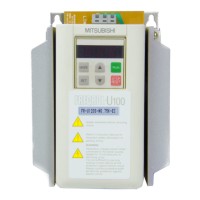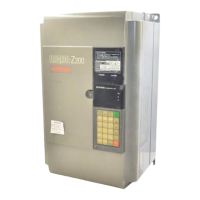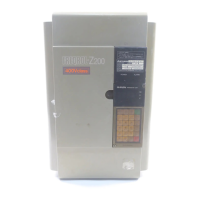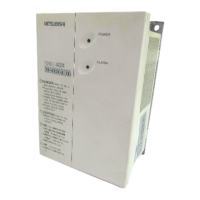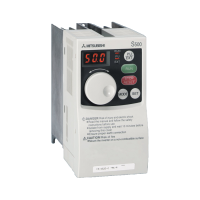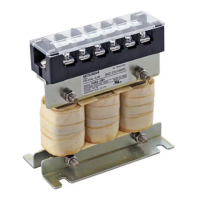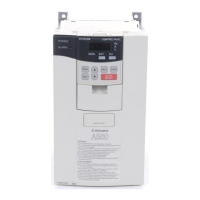Do you have a question about the Mitsubishi FREQROL-E700 and is the answer not in the manual?
Always read and understand safety precautions before operating the equipment.
Measures to prevent electric shock during installation and operation.
Guidelines to prevent fire hazards associated with inverter use.
Precautions to prevent injuries from incorrect inverter handling.
Important safety measures for transportation, mounting, and operation.
Covers safety during usage, emergency stop procedures, and maintenance.
Explains the purpose and content of this training document.
Lists other relevant manuals and documentation for the inverter.
Introduces inverters as devices used to control motor speed.
Lists advantages such as speed control, energy saving, and smooth operation.
Examples of inverter usage in belt conveyors and ventilation fans.
Explains how motor speed is controlled by varying the frequency of current.
Describes how rotating magnetic fields cause a motor's rotor to rotate.
Details the converter, inverter, and control circuit sections of the inverter.
Introduces Mitsubishi's range of general-purpose inverters.
Presents an overview of different inverter series and their applications.
Details features of specific inverter models like FR-F800 and MM-EFS.
Covers FR-E700, FR-D700, FR-A800, and FR-V500 series.
Explains the naming convention for inverter models and their specifications.
Identifies key components and terminals of the FR-E700 inverter.
Instructions for removing and reinstalling the inverter's front and wiring covers.
Details connecting single-phase and three-phase power to the inverter.
Explains the terminal layout and proper wiring procedures.
Instructions for stripping wires and crimping blade terminals.
Covers surface mounting and vertical installation of the inverter.
Specifies required clearances for heat dissipation and maintenance.
Guidelines for multiple inverter arrangements and ventilation.
Explains fault/alarm indications, categorization, and resetting procedures.
Introduces the concept of parameters for configuring inverter operation.
Explains parameters and lists commonly used ones for setup.
Identifies and describes the functions of the operation panel keys and display.
Explains the capability of controlling the inverter with various signals.
Details how to select between PU, External, and Network operation modes.
Describes External and PU operation modes.
Details External/PU operation modes 1 and 2.
Steps to restore inverter parameters to their initial values.
Setting the electronic thermal O/L relay for motor protection.
Adjusting inverter output to match the motor rating.
Correcting voltage drops and improving torque at low speeds.
Restricting motor speed by setting upper and lower frequency limits.
Setting the time for acceleration and deceleration of motor speed.
Explains how FR Configurator simplifies parameter setup and data management.
Lists required hardware and describes PC to inverter connection.
Details the options available in the FR Configurator startup window.
Describes the Navigation, Monitor, and System areas of the main window.
Explains how to navigate and access functions within the Navigation area.
Details functions like Parameter List, Diagnosis, and Convert.
Describes functions for monitoring inverter data (Graph, Analyzer, etc.).
Outlines the step-by-step process for configuring the inverter using Easy Setup.
Inputting system name and comments for creating a system file.
Adjusting communication parameters like port, speed, and parity.
Choosing between automatic recognition or manual model setting.
Process for detecting inverters available for communication.
Selecting an inverter station number for parameter configuration.
Setting the specific control method for the selected inverter.
Inputting motor information and adjusting monitor units.
Choosing how to input start commands and frequency settings.
Displaying configured parameters and writing them to the inverter.
Lists functions like reading, writing, clearing, and searching parameters.
Performing batch reads, writes, and verifications of inverter parameters.
Procedures for clearing individual or all inverter parameters.
Explains the role of GOT (Graphic Operation Terminal) in inverter control.
Illustrates the wiring between the GOT and inverter using RS-485.
Sets parameters like station number, speed, and stop bits for GOT communication.
Steps to configure GOT communication settings using GT Designer3 software.
Explains using FX5 PLCs for inverter monitoring and control via RS-485.
Describes using RS-485 ports, communication boards, and adapters.
Details peer-to-peer connections using the PU connector.
Connecting terminating resistors on the PLC and inverter sides.
Wiring diagrams for connecting single/multiple inverters (4-wire type).
Wiring diagrams for connecting single/multiple inverters (2-wire type).
Lists essential parameters for inverter-PLC communication.
Steps to configure communication settings using GX Works3 software.
Setting up analog inputs (voltage/current) for frequency control.
Step-by-step guide for operating the inverter with a potentiometer.
Introduces the review questions based on previous content.
Defines control requirements for a belt conveyor system.
Practicing parameter loading, clearing, and writing with FR Configurator.
Questions on parameter change procedures and fault display matching.
Matching operations with the correct panel buttons.
Determining correct parameter values for optimal inverter operation.
Always read and understand safety precautions before operating the equipment.
Measures to prevent electric shock during installation and operation.
Guidelines to prevent fire hazards associated with inverter use.
Precautions to prevent injuries from incorrect inverter handling.
Important safety measures for transportation, mounting, and operation.
Covers safety during usage, emergency stop procedures, and maintenance.
Explains the purpose and content of this training document.
Lists other relevant manuals and documentation for the inverter.
Introduces inverters as devices used to control motor speed.
Lists advantages such as speed control, energy saving, and smooth operation.
Examples of inverter usage in belt conveyors and ventilation fans.
Explains how motor speed is controlled by varying the frequency of current.
Describes how rotating magnetic fields cause a motor's rotor to rotate.
Details the converter, inverter, and control circuit sections of the inverter.
Introduces Mitsubishi's range of general-purpose inverters.
Presents an overview of different inverter series and their applications.
Details features of specific inverter models like FR-F800 and MM-EFS.
Covers FR-E700, FR-D700, FR-A800, and FR-V500 series.
Explains the naming convention for inverter models and their specifications.
Identifies key components and terminals of the FR-E700 inverter.
Instructions for removing and reinstalling the inverter's front and wiring covers.
Details connecting single-phase and three-phase power to the inverter.
Explains the terminal layout and proper wiring procedures.
Instructions for stripping wires and crimping blade terminals.
Covers surface mounting and vertical installation of the inverter.
Specifies required clearances for heat dissipation and maintenance.
Guidelines for multiple inverter arrangements and ventilation.
Explains fault/alarm indications, categorization, and resetting procedures.
Introduces the concept of parameters for configuring inverter operation.
Explains parameters and lists commonly used ones for setup.
Identifies and describes the functions of the operation panel keys and display.
Explains the capability of controlling the inverter with various signals.
Details how to select between PU, External, and Network operation modes.
Describes External and PU operation modes.
Details External/PU operation modes 1 and 2.
Steps to restore inverter parameters to their initial values.
Setting the electronic thermal O/L relay for motor protection.
Adjusting inverter output to match the motor rating.
Correcting voltage drops and improving torque at low speeds.
Restricting motor speed by setting upper and lower frequency limits.
Setting the time for acceleration and deceleration of motor speed.
Explains how FR Configurator simplifies parameter setup and data management.
Lists required hardware and describes PC to inverter connection.
Details the options available in the FR Configurator startup window.
Describes the Navigation, Monitor, and System areas of the main window.
Explains how to navigate and access functions within the Navigation area.
Details functions like Parameter List, Diagnosis, and Convert.
Describes functions for monitoring inverter data (Graph, Analyzer, etc.).
Outlines the step-by-step process for configuring the inverter using Easy Setup.
Inputting system name and comments for creating a system file.
Adjusting communication parameters like port, speed, and parity.
Choosing between automatic recognition or manual model setting.
Process for detecting inverters available for communication.
Selecting an inverter station number for parameter configuration.
Setting the specific control method for the selected inverter.
Inputting motor information and adjusting monitor units.
Choosing how to input start commands and frequency settings.
Displaying configured parameters and writing them to the inverter.
Lists functions like reading, writing, clearing, and searching parameters.
Performing batch reads, writes, and verifications of inverter parameters.
Procedures for clearing individual or all inverter parameters.
Explains the role of GOT (Graphic Operation Terminal) in inverter control.
Illustrates the wiring between the GOT and inverter using RS-485.
Sets parameters like station number, speed, and stop bits for GOT communication.
Steps to configure GOT communication settings using GT Designer3 software.
Explains using FX5 PLCs for inverter monitoring and control via RS-485.
Describes using RS-485 ports, communication boards, and adapters.
Details peer-to-peer connections using the PU connector.
Connecting terminating resistors on the PLC and inverter sides.
Wiring diagrams for connecting single/multiple inverters (4-wire type).
Wiring diagrams for connecting single/multiple inverters (2-wire type).
Lists essential parameters for inverter-PLC communication.
Steps to configure communication settings using GX Works3 software.
Setting up analog inputs (voltage/current) for frequency control.
Step-by-step guide for operating the inverter with a potentiometer.
Introduces the review questions based on previous content.
Defines control requirements for a belt conveyor system.
Practicing parameter loading, clearing, and writing with FR Configurator.
Questions on parameter change procedures and fault display matching.
Matching operations with the correct panel buttons.
Determining correct parameter values for optimal inverter operation.
| Series | FREQROL-E700 |
|---|---|
| Output Frequency | 0 to 400Hz |
| Control Method | V/F control, Vector control |
| Overload Capacity | 150% for 60 seconds |
| Protection Functions | Over voltage, Under voltage, Over current, Overload, Phase loss |
| Communication Protocols | CC-Link, Profibus-DP |
| Built-in Functions | PID control |
| Braking Unit | Built-in optional |
| Ambient Temperature | -10 to +50°C |
| Storage Temperature | -20 to +65°C |
| Humidity | Up to 90% (non-condensing) |
| Altitude | Up to 1000m above sea level |
| Enclosure | IP20 |
| Cooling Method | Forced air cooling (fan) |
| Input Voltage | 200V, 400V |
